Facing any Fiddle Leaf Problems?
Has your beloved fiddle leaf fig started looking a little sickly lately?
or maybe some of its leaves turning brown or dropping off, and you’re worried about how to save it?
If you want to quickly solve any problems with your plant and restore its health, keep reading. In this guide, we’ll provide solutions for common issues with fiddle leaf figs, such as leaves falling off, changing color, root rot, bacteria, and more.
With more than 20 years of experience nurturing these beautiful plants, we’ve gathered natural and effective tips to help you diagnose and treat any issue your fiddle leaf fig might encounter.
Fiddle Leaf Problems Caused by Tree Environment
According to Claire Akin from fiddleleaffigplant, “The most common threat to a fiddle leaf fig’s health is its environment.”
Light
Fiddle leaf figs like bright, indirect light. as Kiersten Rankel stated at greg say ” it’s all about balance. Too much sun, and your plant will cook. Too little, and it’ll look like it’s been on a Netflix binge. Find that Goldilocks zone of light, and you’ll have a happy, healthy Fiddle Leaf Fig.”
Humidity
These plants prefer warm, humid conditions, like where they come from in tropical West Africa. Dry indoor air, can make their leaves turn brown and crispy and make them stressed. So, For me personally, I found that using the humidifier near the plant help the air get more moisture.

Environmental conditions for optimal fiddle leaf health.
Temperature
Cold drafts and too much heat can hurt the leaves. The National Gardening Association says it’s best to keep your fiddle leaf fig between 60-75°F for it to grow well.
Watering
Giving too much or too little water can be a problem. So, it’s important to water them regularly when the top layer of soil feels dry. Also, make sure they have good drainage so they don’t sit in water.
main problems caused by the environment
- Leaf Health Issues
- Drooping Leaves and Leaf Drop
- Leaf Discoloration
- Brown Leaf Tips
- Brown Spots On Leaves
- Yellowing Leaves
- Red Spots On Leaves
- Structural Issues
- Cracking Leaves
- Lopsided Growth
- Webbing Between Stems
- Growth Abnormalities
- Lack Of New Growth
- Pest and Disease Symptoms
- Black Spots On Leaves
- White Fluff On Leaves and Stems
Leaf Health Issues
Drooping Leaves and Leaf Drop
It can be alarming when your fiddle leaf fig starts dropping leaves or you notice the leaves drooping down. What causes this, and how can you fix it?
There are a few key reasons you may see fiddle leaf fig leaves falling off or becoming limp and droopy.
Overwatering is a prime culprit for leaf drop (Texas A&M AgriLife Extension). If the leaves were turning yellow before falling off, too much moisture is likely the issue. Underwatering can also cause leaves to drop – the plant becomes stressed from lack of water.
Sudden temperature changes send some plants into shock, consequently resulting in dropped leaves. Check for cold drafts or heat sources like AC vents or radiators near your fiddle leaf fig. Keep it in an area with consistent comfortable temps.
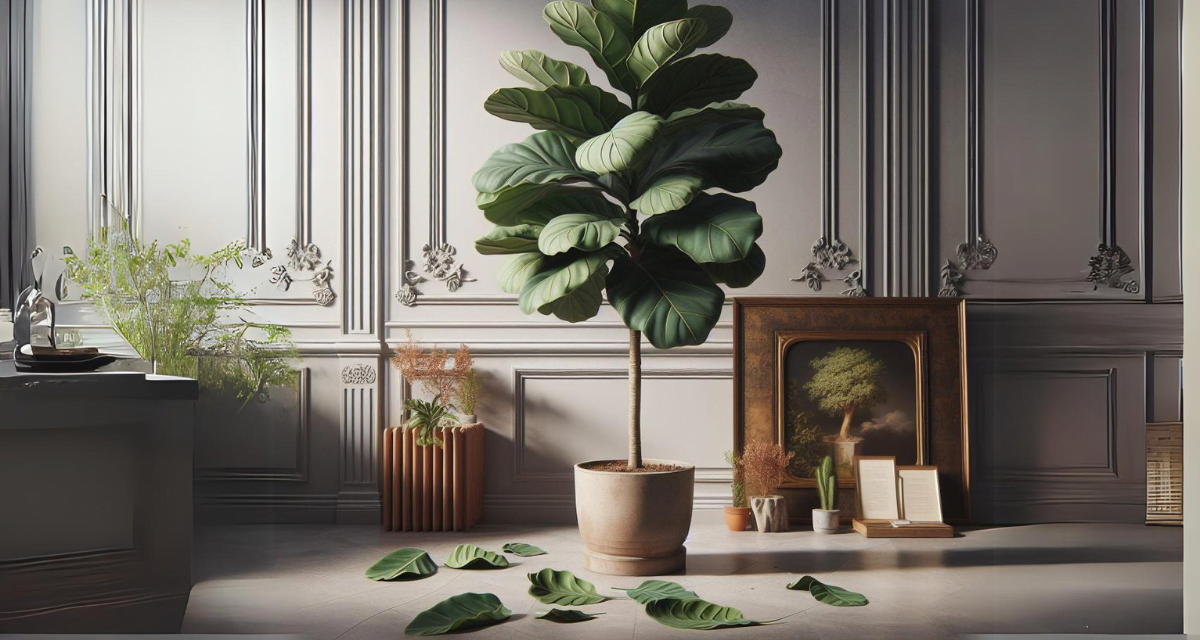
fiddle leaf problems : dropping leaves
Repotting or moving the plant to a new spot can also trigger leaf drop due to shock. Fiddle leaf figs don’t like change, so try to keep them in one stable location.
Pests are another possibility if you see spots on dropped leaves. Inspect closely for signs of insects sucking sap or munching on leaves. Treat any infestations promptly.
Dry air and strong direct light will cause leaves to drop or wilt. However, these plants prefer humid conditions and bright, indirect light. So, keep them away from heating/cooling vents and drafty windows.
Catching the cause early and addressing issues like watering, temperature, pests, etc can help minimize lasting damage if your fiddle leaf fig is dropping leaves. Furthermore, with proper adjustments, it will regrow new healthy foliage.
ficus lyrata Leaf Discoloration
brown spots on fiddle leaf fig
Brown spots on your fiddle’s leaves? It’s okay. A couple things could be causing those. But we’ll figure it out. Then you can make it better. And no more yucky brown spots. Promise!
Are you overwatering your plant?
When there’s excess moisture, brown spots might appear on your fiddle leaf fig’s leaves, and they might turn yellow, get rotted, or fall off. To fix this, let the soil dry out more before watering again.
Or are you possibly underwatering instead?
Drought stress can cause drying brown spots on fiddle leaf fig leaves when the plant is not getting enough hydration. Increase watering frequency.
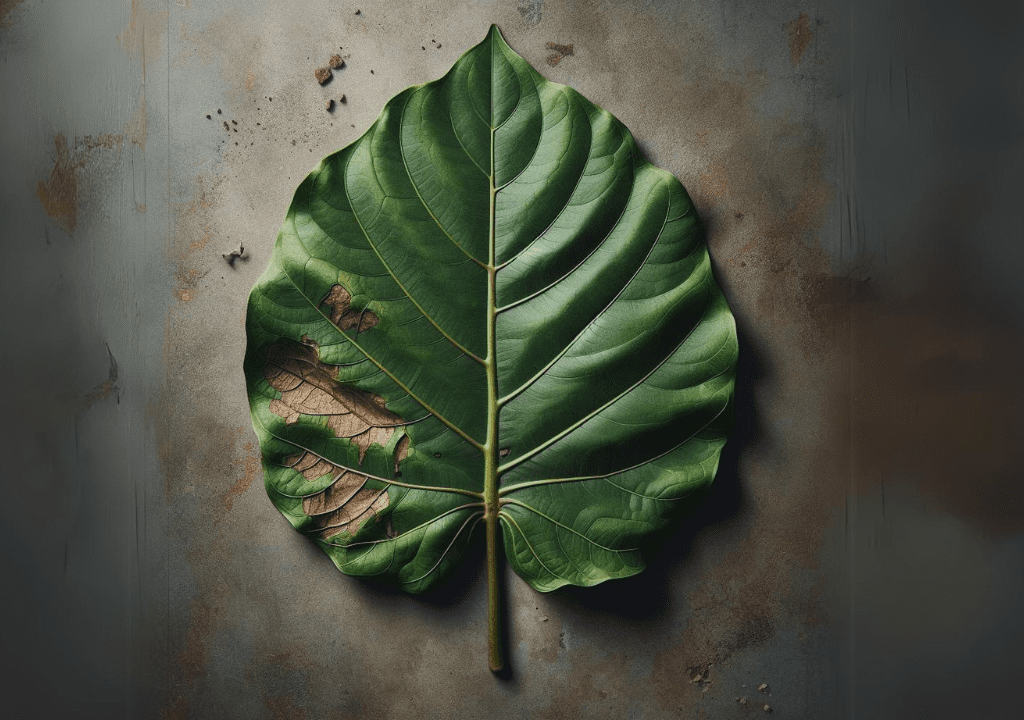
brown spots on fiddle leaf fig
Could it be a nutrient deficiency?
Sometimes too much moisture can make those brown spots pop up on your fiddle’s leaves. Also, they might even turn yellow, get all rotted, or start dropping off. Yikes!
But no worries, friend. To clear that up, simply let the soil dry out a bit more between waterings. That’ll do the trick.
Have you checked thoroughly for pests?
Bugs like spider mites cause stippling and brown spots on fiddle leaf fig leaves. Therefore, treat any infestations detected right away.
Is bacterial infection a possibility?
Leaf spots with yellow halos may indicate a bacterial or fungal problem. So, isolate the plant and apply a copper-based product.
Are the leaves receiving too much harsh light or dry air?
This environment leads to crispy brown spots on fiddle leaf fig leaves and tips. Filter bright light and increase humidity.
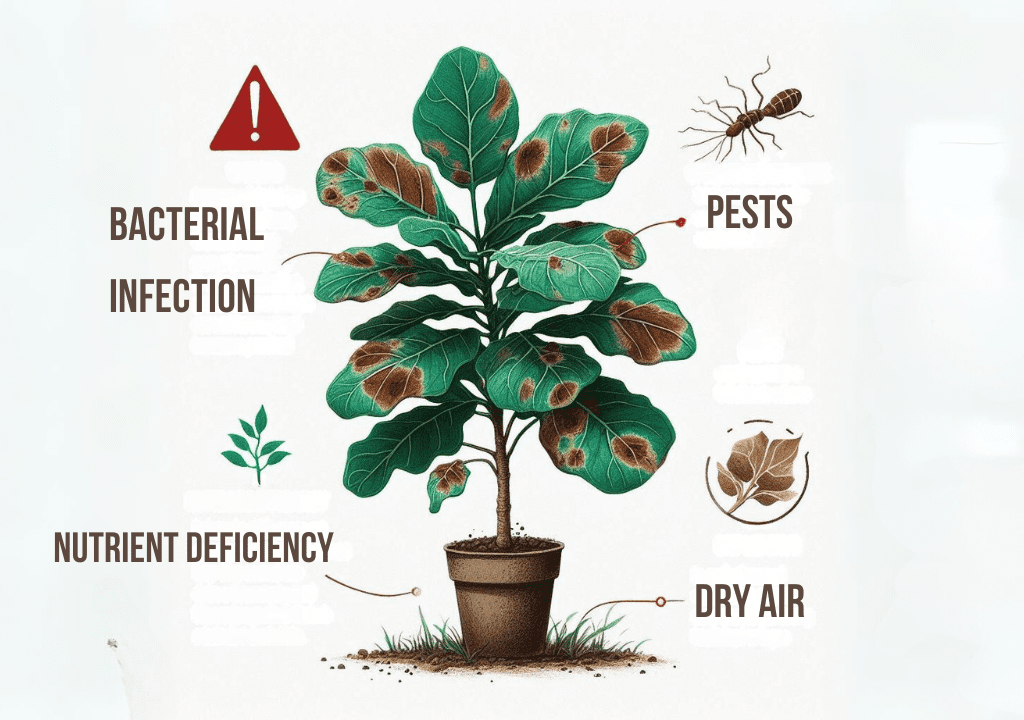
main causes for brown leaves on fiddle leaf fig
yellow patches on leaves OR yellowing leaves
If you’re seeing yellow spots on your fiddle leaf fig or its leaves are turning yellow, here are some possible reasons:
- Not enough light: Your plant might not be getting enough sunlight, which it needs to grow. Therefore, try moving it to a brighter spot.
- Underfertilizing: Nutrient deficiencies, such as lack of nitrogen, magnesium, or potassium, can cause yellowing. Consequently, to remedy this, apply a balanced fertilizer at regular intervals.
- Overwatering: Excess moisture can lead to root rot and yellow, dropped leaves. Therefore, to prevent this, allow the soil to dry out between waterings and improve drainage.
- Insect infestation: insects like spider mites feed on leaves, causing yellow stippling and spots. Therefore, inspect your plant closely for any signs of infestation and take appropriate measures.
- Repotting or moving : can shock the roots, disrupting nutrient uptake and resulting in yellow leaves. To minimize transplant shock, avoid sudden changes in the environment or repotting.

main causes for yellow patches on ficus lyrata leaves
red spots on fiddle leaf fig
Uh oh, spotted some red spots on fiddle leaf fig ? No need to panic! Those little red spots are probably just edema.
Moreover, as edema is a super common issue with fiddle leaf figs. Basically, it’s when the plant takes in more water than the leaves can handle. The extra moisture builds up pressure inside until some of the leaf cells burst, causing those red, blister-like spots.
Furthermore, as missouri botanical garden stated a few mild spots here and there aren’t a huge deal, especially if your fiddle is sprouting new growth. Those fresh leaves need lots of hydration to develop properly. So some edema during those growth spurts is actually normal.
Recently, I’ve observed red spots on my fiddle leaf fig leaves, leaving me puzzled about their cause. Subsequently, after some research, I stumbled upon a helpful article on The Sill’s blog. It serves as a great starting point for me to understand and tackle the issue.
Additionally, if the edema is mild, odds are the spots will fade over time as the leaves mature. Your new growth should emerge nice and green without any blemishes. Consistency is key here.
But if you keep messing with the moisture levels, those spots will only get worse. Your poor fiddle might start pushing out straight up damaged leaves. So grab yourself a moisture meter and get that watering routine on point.
In conclusion, relax if you see some light red spotting. It’s likely just edema from wonky watering. Fix that pattern and your fiddle will be back to putting out beautiful, blemish-free foliage in no time!
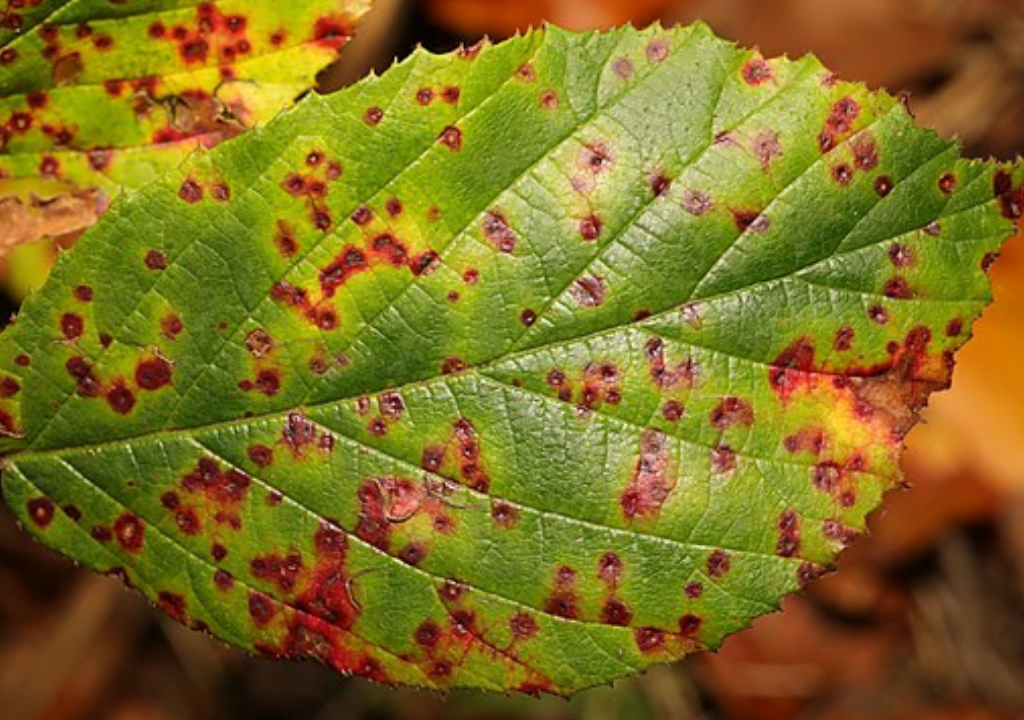
red spots on a plant leaf
white spots on fiddle leaf fig or white dots on fiddle leaf fig
Seeing strange white patches, dots, or powdery fuzz on your fiddle leaf fig? This is usually caused by one of the following:
- Hard water : White spots from mineral deposits in tap water. Gently wipe leaves with diluted castile soap and water.
- Powdery mildew : A fungal infection flourishing in humidity. Appears as white powdery coating on leaves.
- Pests : Insects like mealybugs and scale can cause white spots. Check for bugs or webbing.
- Diseases : Issues like root rot and leaf spot also create spots. May see other discoloration.
- Sunburn : Direct light scorches leaves, resulting in white patches and browning. Leaves may also curl.
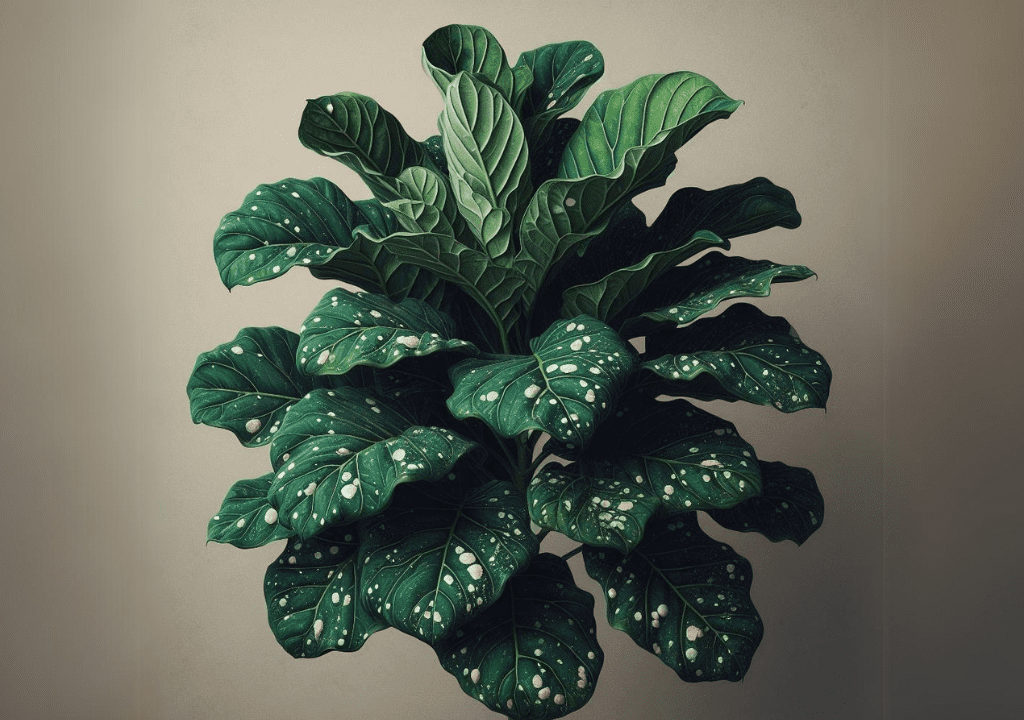
white spots on fiddle leaf fig
How to treat white spots on fiddle leaf fig or white dots on fiddle leaf fig
To begin with, gently wash the leaves with soapy water. Ensure to use water that won’t harm them. Remove any sick leaves and use the right spray to fight bugs or fungus. Additionally, allow more air around the plant and keep it out of direct sunlight. If you catch white spots early, you can save the plant and keep its leaves green and healthy.
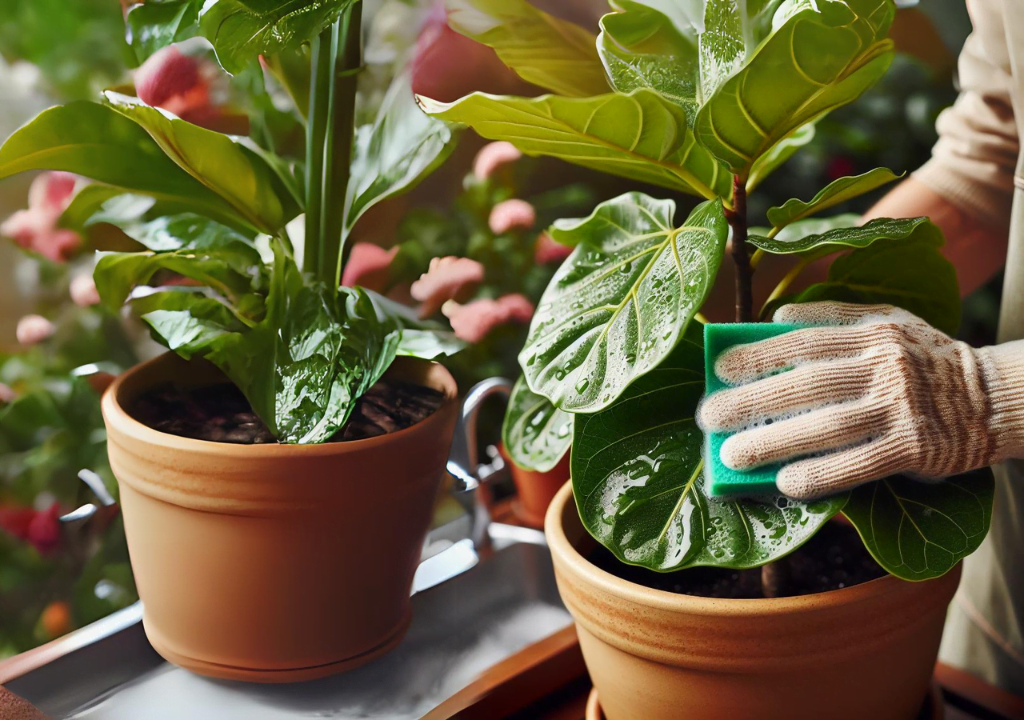
using the soapy water to get rid of deseases on fiddle leaf fig
fig Structural Issues
fiddle leaf cracking leaves
Firstly dry air causes cracking. Specifically, heaters and AC make indoor air very dry. As a result, this dehydrates leaves, and they crack.
Next, increase humidity around the plant. Additionally, you can use a humidifier or mist leaves with filtered water. This way, you restore moisture to prevent cracks.
Additionally, underwatering can lead to cracking. When soil gets too dry, leaves do not get enough hydration. Consequently, they become stiff and crack more readily with handling.

Pests are another factor. Bugs weaken plant health over time. Therefore, inspect closely for insects and treat any found immediately. Sticky traps or insecticidal soap can help.
Finally, physical damage makes existing cracks worse. If leaves get bumped in high traffic areas they crack more. Thus, move the plant to a protected spot.
I ran into this issue a while back when my fiddle leaf fig started getting cracks all over its beautiful leaves. At first I panicked, but then realized the culprit was the dry air being pumped out by my new space heater.
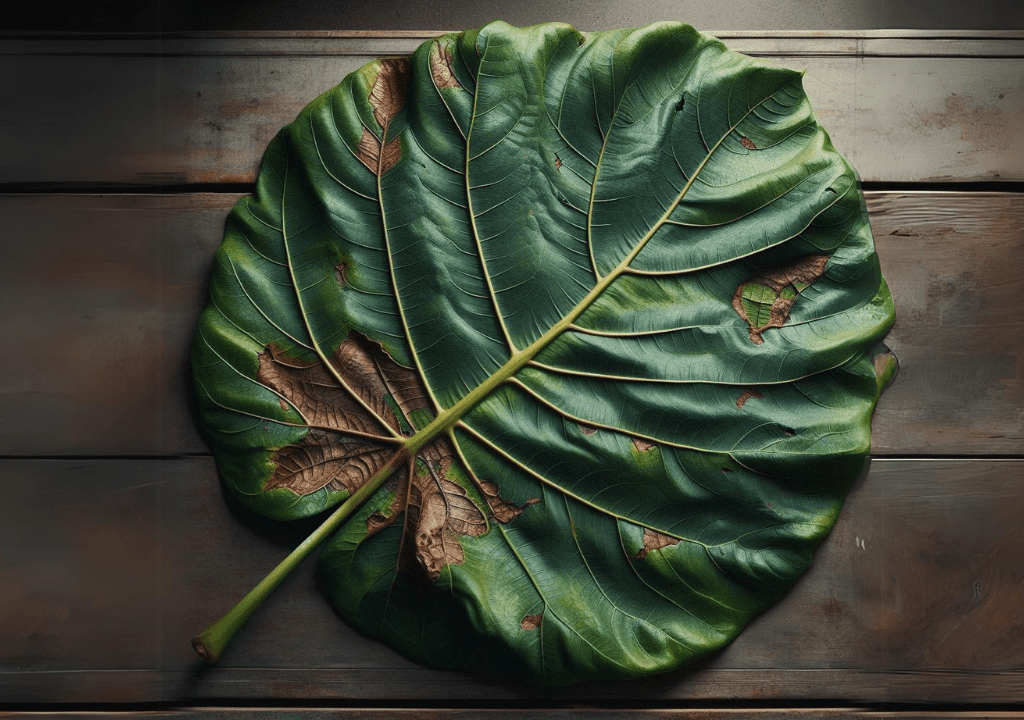
I started misting my fiddle leaf fig twice a day to increase moisture on the leaves. I also moved it next to a little humidifier I bought. Within about 3 weeks, I noticed new growth was looking much healthier without any cracks.
It took about a month of consistent misting and added humidity before all the leaves regained their lush look. The few with major crack damage did eventually have to be pruned, but new growth replaced them quickly. It was such a relief to see my fiddle happy again!
fiddle leaf fig Growth Abnormalities
fiddle leaf fig small new growth
If your fiddle leaf fig has tiny new leaves or lacks new growth, there are a few potential causes:
- Fertilizer:
- Not giving plants enough food makes their leaves weak. Give them liquid food every week.
- Low Light:
- Plants need sunlight to make energy. Keep them near bright, not too sunny spots. Clean their leaves from dust.
- Underwatering:
- Forgetting to water plants enough makes their leaves dry up. Water them more when the top soil is dry.
- Shock:
- Moving plants or changing their pots can scare them. Wait until they get used to it before expecting new leaves.
- Cold Weather:
- Cold weather can make plants grow slower. Keep them warm (above 60°F) to help them grow better.
To help your fiddle leaf fig grow well again, it’s important to understand what it needs. First, check if it’s getting enough nutrients, light, and water. Give it regular care based on what it requires. Then, it will start growing big, beautiful leaves like before. Additionally, remember to give it some time to adjust after any changes you make.
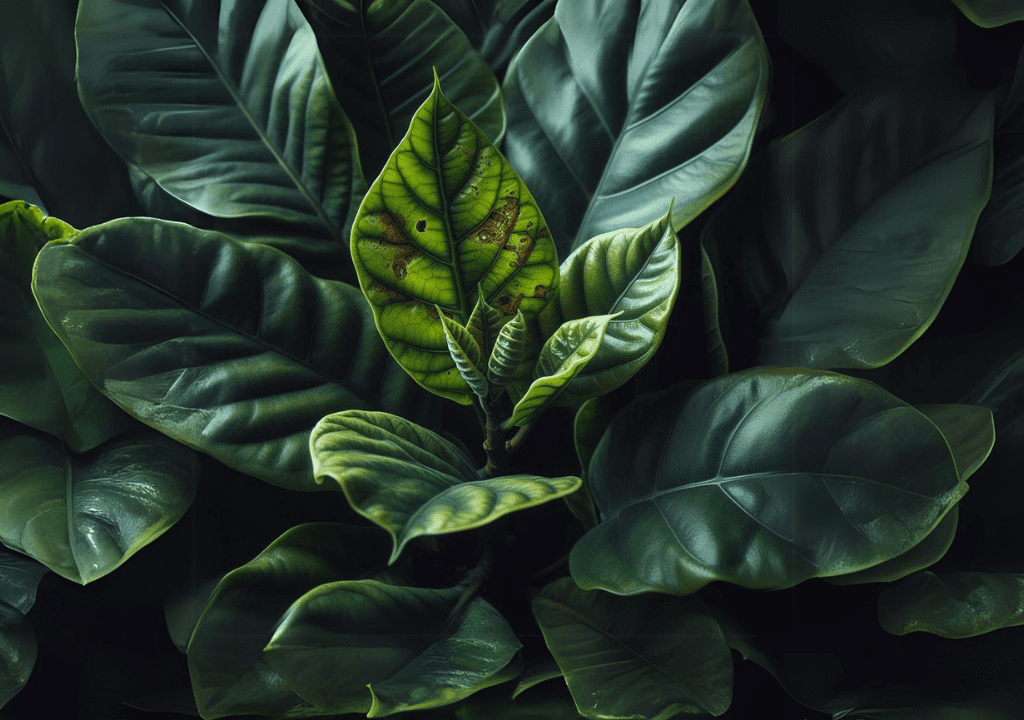
fiddle leaf fig small new growth
insects and little bugs in fiddle leaf fig
Just like other plants, fiddle leaf figs can attract bugs. These bugs steal nutrients and water, leading to diseases and leaf damage. Consequently, if ignored, they can weaken or even kill the plant. Therefore, it’s essential to detect these bugs early. Furthermore, understanding which bugs are common helps you address them faster. To assist you in recognizing and addressing them promptly, we’ll discuss the bugs you might find on your fiddle leaf fig.
Aphids
Aphids are small, soft insects, green or black, that often bother fiddle leaf figs. Additionally, they gather in groups on new leaves and under them, poking stems and leaves to suck plant juice.
Signs of an aphid problem
- Sticky honeydew residue,
- Deformed and curling leaves,
- Yellow spotted foliage, and
- Leaf drop.
Plants badly infested by these prolific reproducers can become weakened.
Catching infestations early allows the plant to recover more quickly. But left uncontrolled, thriving aphid colonies can contribute to overall poor plant health. Be vigilant and act fast if small green bugs start accumulating on tender new growth.
Aphids traitment for fiddle leaf plant
To treat aphids:
- Isolate the plant and prune off heavily infected parts.
- Spray thoroughly with insecticidal soap or neem oil, targeting the undersides of leaves.
- Apply every 5-7 days for 2-3 weeks to kill aphids through development stages.
- Additionally, sticky traps can help trap wingless adults.
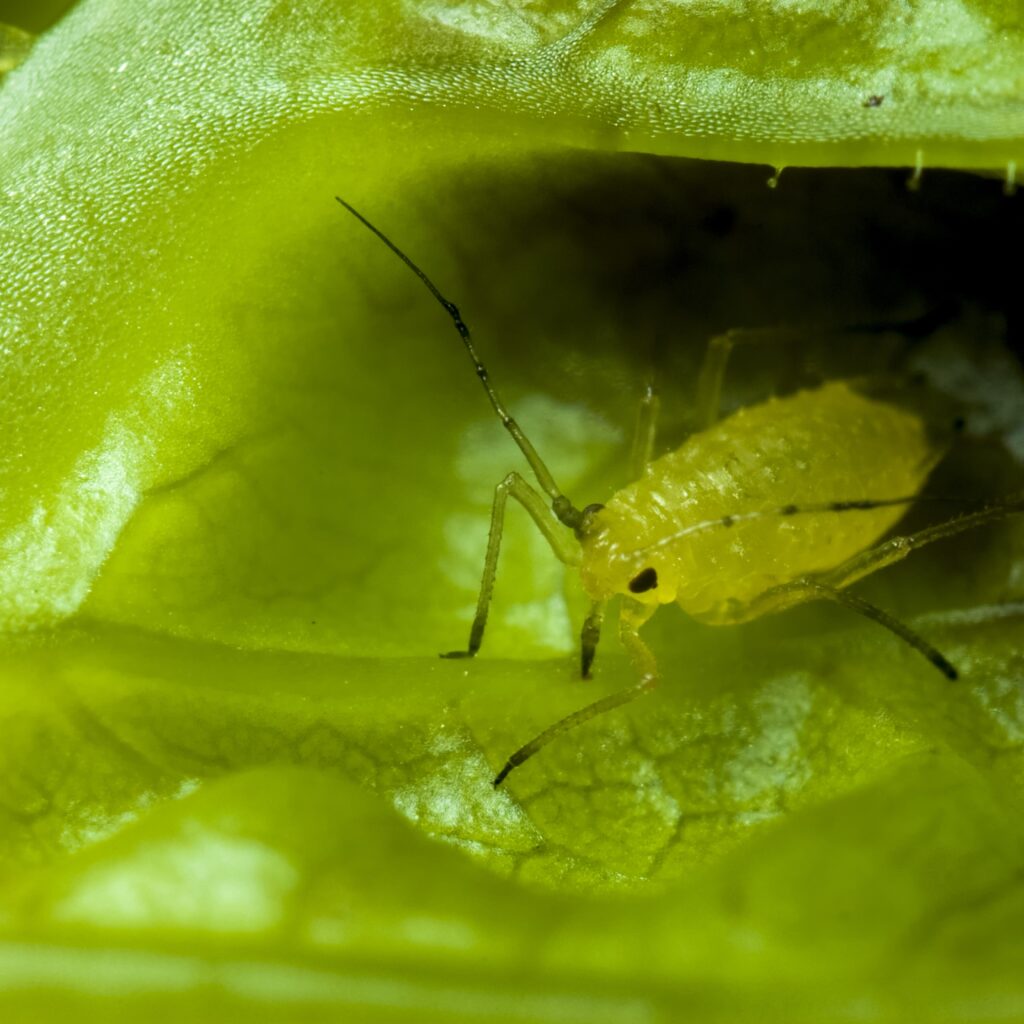
close up aphide bug on a fiddle leaf plant
Scales on fiddle leaf
Scales are small immobile insects that attach themselves to stems, undersides of leaves, and other plant parts to feed on sap. Moreover, they appear as hard bumps (3-5mm) that resemble plant growths, making them easy to overlook.
Signs of scales
- Sticky honeydew residue on plants and nearby surfaces
- Yellowing leaves, deformed growth, leaf drop due to sap loss
- White waxy shell-like covers over bugs when fully mature
Scales rarely move, only in their short “crawler” juvenile stage. So heavy infestations build up undetected over time, progressively weakening plants. Catching them early prevents major damage.
Scales traitment for fiddle leaf plant
If discovered early, scale can be managed. But their protective covers make chemical penetration difficult:
- Isolate infected plants to prevent spread
- Manually crush scales with cotton swabs and alcohol
- Apply insecticidal soap spray every 10 days for 2 months
- Monitor closely for reappearance of crawlers
Vigilance is needed to disrupt rapid scale life cycles. If uncontrolled, these sap-feeding insects can eventually kill fiddle leaf figs and other plants. But taking swift action at the first sign of scales can save your plant.

scales insects on a plant leaf
Sally’s Fight Against Scales
A friend from the blog shared her journey of battling with scales and generously offered us some valuable tips that she personally used.
Hey y’all, Sally here. I noticed weird bumps on my fiddle leaf fig and freaked – scale bugs! I’d heard they could kill plants fast if not stopped. Subsequently,
I immediately isolated that plant so they wouldn’t spread to others. I used a toothpick carefully to crush each hard scale – super tedious but so necessary.

scales on a plant stem
credit to Gilles San Martin from Namur, Belgium,https://creativecommons.org/licenses/by-sa/2.0
The trick was spraying the plant thoroughly with insecticidal soap every 10 days like clockwork for 2 solid months. Consequently, this helped kill newly hatched crawler scales under the shell.
I won’t sugarcoat it…it was tough work. But I refused to give up on my precious plant! Month after month, I was vigilant in finding stray scales and dousing everything in soapy spray.
In the end, all that persistence paid off! After being so proactive spotting and smooshing and spraying those creepy crawlers, my fiddle leaf fig bounced back beautifully. Just gotta stay on top of ’em!”
Spider Mites
Spider mites are tiny pests that look like moving dots to the naked eye. Despite their small size, they can have a huge impact on fiddle leaf figs. These insects pierce plant cells and suck out chlorophyll and cell sap, causing stippling, discolored spots, browning leaves, and leaf loss.
Signs of spider mites
- Fine webbing on branches and underside of leaves
- Clusters of tiny dots that move when disturbed
- Stippling damage and bronze/yellow foliage
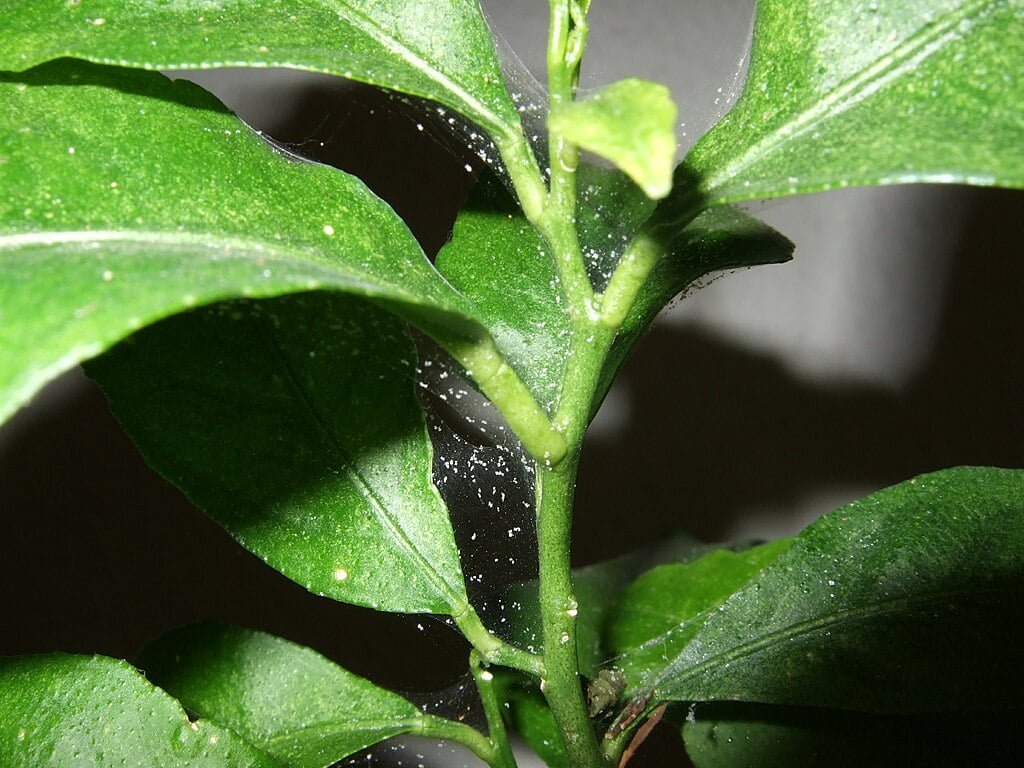
spider mites effects on a indoor plant
Spider Mites traitment for fiddle leaf plant
To treat spider mites:
- Isolate the plant to prevent spread
- Rinse leaves with water to remove mites
- Apply insecticidal soap spray or neem oil to leaves every 5-7 days for 2-3 weeks
Catching an infestation early allows fiddle leaf figs to recover more quickly. But spider mites reproduce rapidly, so unchecked they can quickly compromising plant health, vigour, and appearance. Keep an eye out for any silken threads or speckling as a clue these tiny pests have taken up residence on your plant.

close-up image to a spider mites
Whiteflies
Whiteflies are tiny, moth-like pests that feed on the undersides of fiddle leaf fig leaves. Additionally, these bugs pierce the leaves and suck out sap, leaving behind sticky honeydew residue that, in turn, causes mold growth.
Signs of whiteflies
- Clouds of small white bugs flying around plant when disturbed
- Sticky honeydew coating on leaves
- Sooty mold growing on honeydew
- Distorted, yellowing leaves
Whiteflies traitment for fiddle leaf plant
- Use yellow sticky traps to catch adult whiteflies.
- Apply soapy water or oil to kill eggs and young whiteflies.
- Spray under leaves every 7-10 days for 1-2 months.
Catch whiteflies early to prevent big damage. If left alone, these bugs can harm fiddle leaf plants. Therefore, watch out for swarms of small white bugs.
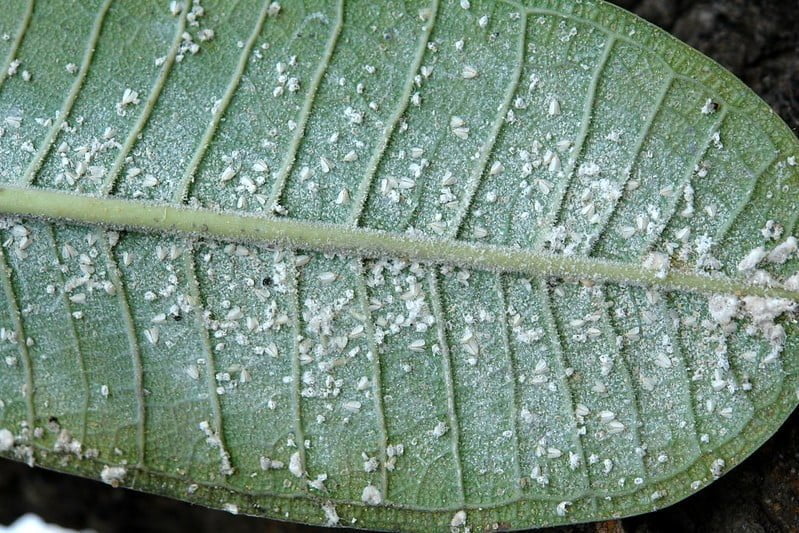
white flies on a plant leaf
Mealybugs
Mealybugs are small, soft-bodied pests that feed on plant sap and excrete sticky honeydew. This invites mold growth and other insects like ants to the plant. Furthermore, these sap-sucking bugs can cause yellowing, wilting leaves, and transmit plant diseases.
Signs of mealybugs
- White cottony clusters on stems and leaf joints
- Honeydew residue and black sooty mold
- Slowed growth and yellowing leaves
Whiteflies traitment for fiddle leaf plant
To start treating the infestation, isolate the affected plant to stop the spread of mealybugs. Then, trim away heavily infested parts and discard them.
Next, apply insecticidal soap or 70% isopropyl alcohol directly to the bugs, making sure to reach all the hiding spots. Alternatively , use a spray made of alcohol and water.
You can also try natural options like horticultural oils and neem oil solutions. Additionally, use sticky traps to catch some adult bugs, and if you’re outside, encourage beneficial insects like ladybugs.
For severe infestations, use a pyrethrum pesticide spray made for mealybugs. Additionally, always follow the instructions on the label.
Prevention is key, so keep the air circulating well, maintain the right humidity, and water your plants correctly. Finally, stay on the lookout for any signs of infestation and act promptly.
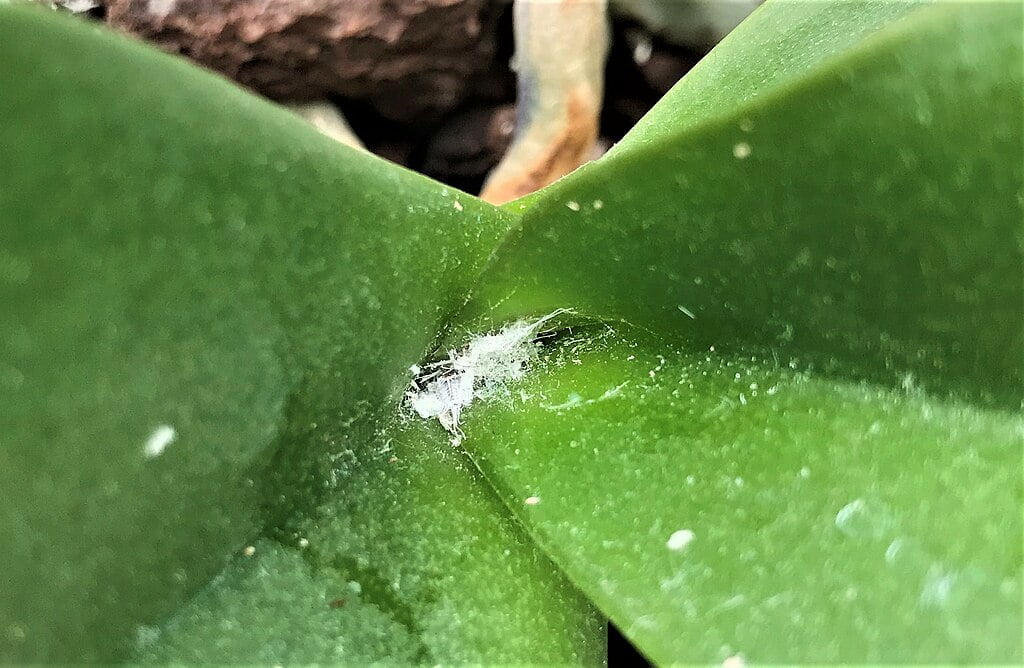
mealybugs on a plant leaf
credit to Sinikka Halme, CC BY-SA 4.0 https://creativecommons.org/licenses/by-sa/4.0
Common Diseases in Fiddle Leaf Fig plant
Root Rot
Root rot loves soggy soil and attacks roots. It happens when you water too much, or your pot’s too big, trapping moisture. Look out for brown spots on leaves and leaves dropping. Without quick help, root rot can kill your plant.
If your fiddle leaf fig’s leaves are droopy and yellow, check its roots. Take it out of the pot – if the soil’s wet and roots are mushy and dark brown, you’ve got root rot. Subsequently, use a clean blade to scrape off the damaged parts.
Put your plant in a new pot with good drainage, just a bit bigger than before. Add gravel at the bottom for air. Use fresh, fast-draining soil.
Only water when the top bit of soil is dry. Let the whole root area dry out for a week or more between waterings. This gives the roots air and stops the fungus from spreading. Additionally, keep an eye on how wet the soil is.
As your plant gets better, cut off any damaged leaves. But don’t take off more than 10%. With some luck and care, you can beat root rot.
Prevention’s the best medicine – use a pot that fits, soil that drains well, and water only when needed. Spotting problems early and changing things up can save your plant’s roots and life.
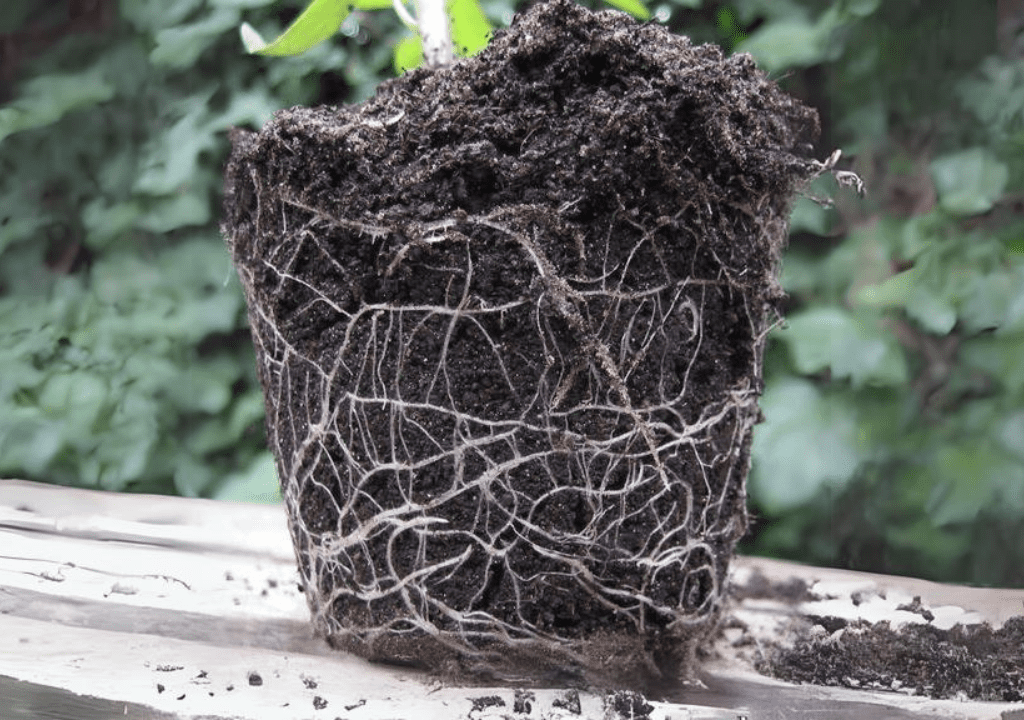
image of a plant suffering from root rot
edema
Typically, noticed some unsightly blisters or bruise-like spots on your fiddle leaf fig’s leaves? That’s likely edema, a super common issue with these plants. Edema, as the Missouri Botanical Garden explains, is a symptom of moisture stress caused by inconsistent watering.Specifically, overwatering leads to root damage and nutrient deficiency
Here’s how it happens: When the roots absorb more water than the leaves can release through transpiration, pressure builds up inside the plant. Eventually, some leaf cells burst, leaving those telltale dark spots or blisters, typically 1-3mm in size.
edema traitment for fiddle leaf plant
Don’t panic! Mild cases of edema are normal, even expected, during periods of new growth when your fiddle needs extra hydration to support those fresh leaves. You may have heard fiddles like to dry out between waterings, but the healthier approach is to adjust your watering based on the plant’s growth cycles.
Increase watering a bit when the plant is actively putting out new foliage, but be sure to also monitor the root health to avoid overwatering and rot. With the right, consistent watering routine moving forward, those spots will fade over time as the damaged leaves mature.

edema effect of a plant leaf
credit to : Rasbak at Dutch Wikipedia, http://creativecommons.org/licenses/by-sa/3.0/, via Wikimedia Commons
how to prevent edema On Fiddle Leaf Fig?
For diligent plant parents, preventing future edema spots on their fiddle leaf fig is very doable. To begin with, start by ensuring your fiddle has well-draining soil and a pot with adequate drainage holes. Additionally, water in the morning rather than evening. Provide ample bright, indirect light and good air circulation.
Stick to this consistent care regimen and any new growth should emerge smooth and spotless. With edema, an ounce of prevention by meeting your plant’s basic needs goes a long way. Follow the right steps and you’ll have a healthy, blemish-free fiddle in no time!
Sum Up
Moisture issues like edema have a common fix : consistent watering.
Structural problems like root rot have a common solution : allow soil to fully dry out, trim rotten roots, and repot in fresh well-draining soil.
Insect infestations have a common treatment : use insecticidal soap or neem oil and quarantine the plant.

